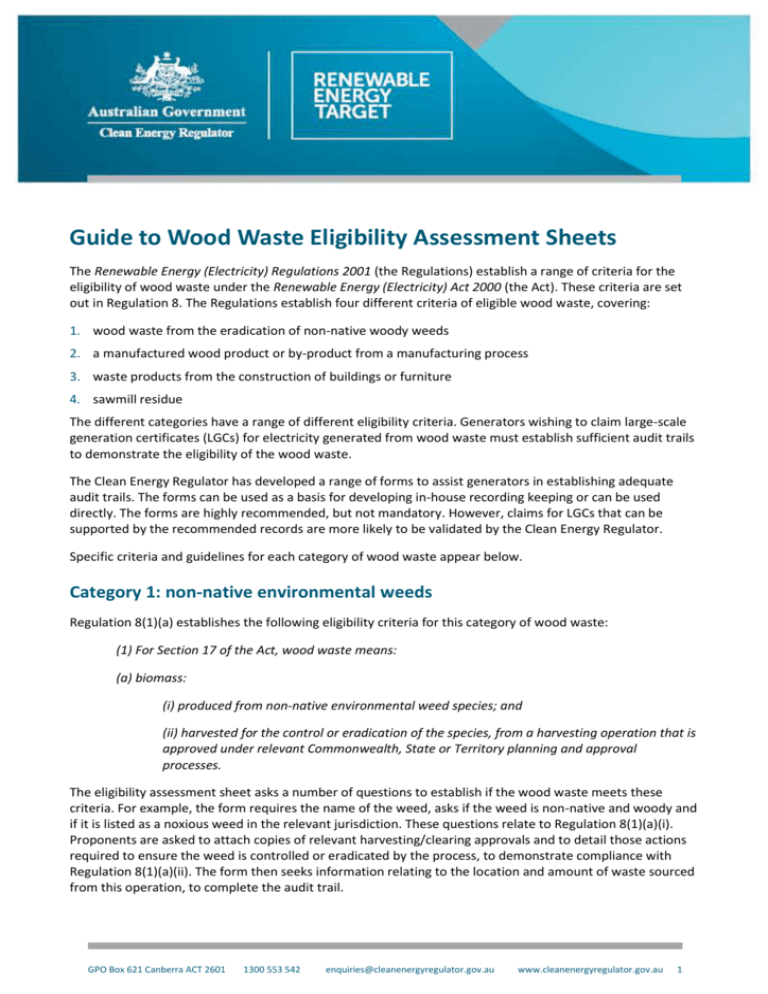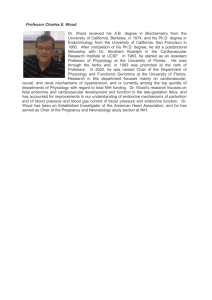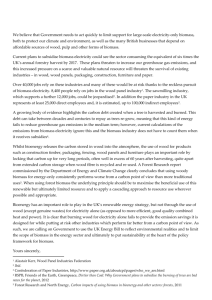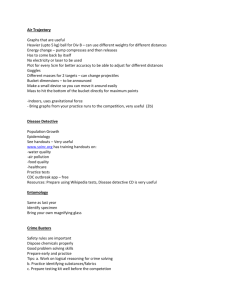Guide to wood waste eligibility assessment sheets
advertisement

Guide to Wood Waste Eligibility Assessment Sheets The Renewable Energy (Electricity) Regulations 2001 (the Regulations) establish a range of criteria for the eligibility of wood waste under the Renewable Energy (Electricity) Act 2000 (the Act). These criteria are set out in Regulation 8. The Regulations establish four different criteria of eligible wood waste, covering: 1. wood waste from the eradication of non-native woody weeds 2. a manufactured wood product or by-product from a manufacturing process 3. waste products from the construction of buildings or furniture 4. sawmill residue The different categories have a range of different eligibility criteria. Generators wishing to claim large-scale generation certificates (LGCs) for electricity generated from wood waste must establish sufficient audit trails to demonstrate the eligibility of the wood waste. The Clean Energy Regulator has developed a range of forms to assist generators in establishing adequate audit trails. The forms can be used as a basis for developing in-house recording keeping or can be used directly. The forms are highly recommended, but not mandatory. However, claims for LGCs that can be supported by the recommended records are more likely to be validated by the Clean Energy Regulator. Specific criteria and guidelines for each category of wood waste appear below. Category 1: non-native environmental weeds Regulation 8(1)(a) establishes the following eligibility criteria for this category of wood waste: (1) For Section 17 of the Act, wood waste means: (a) biomass: (i) produced from non-native environmental weed species; and (ii) harvested for the control or eradication of the species, from a harvesting operation that is approved under relevant Commonwealth, State or Territory planning and approval processes. The eligibility assessment sheet asks a number of questions to establish if the wood waste meets these criteria. For example, the form requires the name of the weed, asks if the weed is non-native and woody and if it is listed as a noxious weed in the relevant jurisdiction. These questions relate to Regulation 8(1)(a)(i). Proponents are asked to attach copies of relevant harvesting/clearing approvals and to detail those actions required to ensure the weed is controlled or eradicated by the process, to demonstrate compliance with Regulation 8(1)(a)(ii). The form then seeks information relating to the location and amount of waste sourced from this operation, to complete the audit trail. GPO Box 621 Canberra ACT 2601 1300 553 542 enquiries@cleanenergyregulator.gov.au www.cleanenergyregulator.gov.au 1 A suggested recording sheet to track wood waste from the site of harvest to the power station where it is used is also provided. This is important in demonstrating the continuity of the audit trail. Separate recording forms should be used for each weed harvest approved under different approval processes or from separate/distinct harvest sites. Category 2: manufactured wood product or by-product from a manufacturing process Regulation 8(1)(b) establishes the following eligibility criteria for this category of wood waste: (1) For Section 17 of the Act wood waste means: (b) a manufactured wood product or a by-product from a manufacturing process, other than a product or a by-product that is derived from biomass from a native forest; Examples for paragraph (b) include: packing cases, pallets, recycled timber, engineered wood product (including one manufactured by binding wood strands, wood particles, wood fibres or wood veneers with adhesives to form a composite). Electricity generated using wood waste under this category derived from biomass from a native forest is not eligible to claim LGCs, unless transitional arrangements apply, (see section discussing native forest biomass later in this guide). This form collects information about the source of the wood waste to determine if the wood waste is likely to be from a manufactured wood product or the manufacture of wood products. The audit trail will be particularly important where the generator does not receive the wood waste prior to it being processed, for example into woodchips, as a visual audit will not confirm that the wood waste falls under this particular eligible category. A suggested tracking sheet is provided to develop an appropriate audit trail. Separate records should be kept where the wood waste is being sourced from different sites. Category 3: waste products from the construction of buildings or furniture Regulation 8(1)(c) establishes the following eligibility criteria for this category of wood waste: (1) For Section 17 of the Act wood waste means: (c) waste products from the construction of buildings or furniture, including timber off-cuts and timber from demolished buildings. This form establishes the source of the wood waste, the main types of activities occurring at the site and a suggested audit trail for appropriate record keeping. Category 4: sawmill residue Regulation 8(1)(d) states that sawmill residue is an eligible source of wood waste, other than sawmill residue derived from biomass from a native forest. Sawmill residue is defined as waste material resulting from the production of squared timber in sawmill operations or rejection by a veneer mill, sawmill or other processing plant (other than a wood chipping plant) of a log found to be defective for the purposes of producing a commercial timber product, where the defect could not have been found on any reasonable inspection of the log before its arrival at the plant for processing. GPO Box 621 Canberra ACT 2601 1300 553 542 enquiries@cleanenergyregulator.gov.au www.cleanenergyregulator.gov.au 2 In order to demonstrate eligibility against this criterion, the form seeks to establish if the waste is sourced from a sawmill, and the waste is a residue from the sawmill. In order to be classified as a sawmill, the Clean Energy Regulator requires demonstration that the relevant jurisdiction has licensed/authorised the facility to operate as a sawmill. An operating licence number or equivalent proof of authorisation to operate as a sawmill is necessary. The Clean Energy Regulator can audit the facility to determine if the sawmill is operating in accordance with all environmental and other controls established by the license or operating approval. The form then seeks to collect information to validate a claim that the wood waste is a residue of the sawmill’s operations. Generators will need to seek estimates of the outputs of the sawmill, in the broad categories of processed wood products (eg sawlogs) and wastes. This information can be used to cross check claims for tonnages of wood waste received from particular sawmills. Electricity generated using wood waste under this category derived from biomass from a native forest is not eligible to claim LGCs, unless transitional arrangements apply, (see section discussing native forest biomass later in this guide). Generators wishing to use sawmill residues to generate eligible electricity will need to maintain appropriate audit trails to demonstrate the wood waste used at the power station was sourced from an authorised sawmill. A suggested tracking sheet is provided. Separate records should be kept for each separate sawmill. Wood waste sourced from a native forest The Renewable Energy (Electricity) Amendment Regulations 2011(No. 5) (the Amendment Regulations) specifically excludes the eligibility of electricity generated using biomass derived from a native forest to create LGCs in certain circumstances. However, Section 4 of the Amendment Regulations establishes a set of transitional arrangements that apply to power station that: a) was accredited under Division 3 of Part 2 of the Renewable Energy (Electricity) Act 2000 on or before 10 July 2011; and b) listed, in the application for accreditation, wood waste as an eligible energy source from which power was intended to be generated; and has created at least one renewable energy certificate that: c) was created because of electricity generated using i) wood waste; and ii) was registered by Power stations that meet the requirements of these transitional regulations may be eligible to apply to have the assessment of their eligibility for LGCs to be considered on the basis of the Regulations preceding the commencement of the Amendment Regulations (the preceding regulations). The preceding regulations set out the eligibility requirements of the different categories of wood waste, and may permit the use of biomass derived from native forest under the following wood waste categories: 5. a manufactured wood product or by-product from a manufacturing process 6. sawmill residue 7. wastes from harvesting native forests GPO Box 621 Canberra ACT 2601 1300 553 542 enquiries@cleanenergyregulator.gov.au www.cleanenergyregulator.gov.au 3 If you would like more information about LGC assessments under the transitional arrangements, or believe that you are eligible for consideration of LGC eligibility under the transitional arrangements, please contact the Clean Energy Regulator at mailto:retpowerstations@cleanenergyregulator.gov.au GPO Box 621 Canberra ACT 2601 1300 553 542 enquiries@cleanenergyregulator.gov.au www.cleanenergyregulator.gov.au 4







